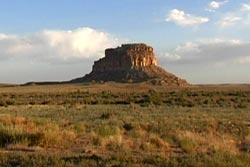
|
||||||
|
|
||||||
|
|
|
|
|
|
|
|
|
|
||||||
|
ABOUT CHACO CANYON
See
a map of Chaco Canyon
Ancient
Chaco
At an elevation of 6,200 feet, Chaco is a high desert, sun-scorched in the summer and bitterly cold in the winter. Despite these harsh conditions, evidence of human presence in the area stretches back to as early as 2900 BC. These groups were largely nomadic, until around AD 200, when the first farmers settled in the area and built small pit houses. Then in roughly AD 850, a great change took place. The people began building in a radically different manner, constructing massive stone buildings unlike any that had been built before. These structures soared to four or five stories and contained up to seven hundred rooms and dozens of kivas . Connected to one another by lines of sight that would have enabled rapid communication, these great houses were feats of engineering. Often built along celestial alignments , they included water-collection systems and were linked to outlying communities by an extensive network of roads. These elaborate buildings evidence a sophisticated and highly organized culture, with Chaco Canyon at its center.
Construction
continued for three hundred years, until about AD 1150, when the area
was abruptly abandoned. It's not completely clear why the people left
Chaco Canyon, but prolonged drought is one possible explanation. It
was around this time that communities in other places in the region,
such as Mesa Verde and the Chuska Mountains, grew in size and importance.
Most likely, the departing
Chacoans
migrated to these surrounding areas.
Modern Chaco In the late 1800s, it became clear that Chaco Canyon needed protection from looting and vandalism. Chaco Canyon National Monument was established soon after, in 1907. In the nearly one hundred years since, the site has been widely excavated, surveyed, and studied. It became a national historical park in 1980, and was designated a UNESCO World Heritage Site in 1987, one of a select list of protected areas "whose outstanding natural and cultural resources form the common inheritance of all mankind." Today, roughly eighty thousand people visit Chaco Canyon each year, most of them drawn to see the remains of the excavated great houses, which are maintained in a state of "arrested decay."
Chaco
Canyon continues to be of great interest to those who study ancient
cultures, including
archeoastronomers
.
Evidence suggests that the Chacoans were expert skywatchers, with
a clear knowledge of the cyclic and seasonal patterns of the sun,
moon, and stars. This knowledge is reflected over and over again in
the architecture of the great houses, and in various observational
and ceremonial sites around the canyon. The most famous among these
sites is the Sun Dagger, a
petroglyph
crafted to mark the cycles of the sun (and possibly also the moon).
Though it's rich with artifacts, much about Chaco Canyon and its early inhabitants remains a mystery. Why did the ancient Pueblo choose to build so extravagantly in so harsh an environment - one with 100-degree summers, frigid subzero winters, and only nine inches of rain each year? Who orchestrated the construction, which took place over several hundred years, and how were these plans transmitted, with no written language? Says park interpreter G. B. Cornucopia, "Everybody who comes here feels that sense of attention that was lavished on this place. And that pulls you in. You want to know, 'Why were they here? What was this all about?' The questions just keep coming." |
||||||
